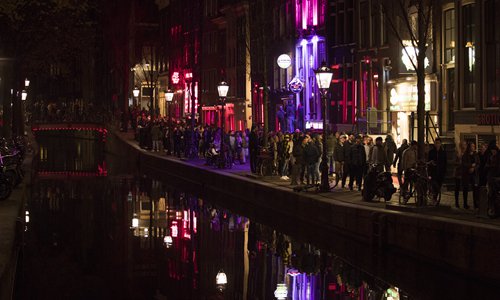HOME >> WORLD
Sex workers give red light to leaving famed Dutch district
Source:AFP Published: 2019/7/31 17:33:40

Tourists crowd the narrow canal-side streets in Amsterdam's red light district, the Netherlands on March 29. Photo: IC
Bathed in red neon light, hundreds of prostitutes ply their trade from behind windows in the narrow canal-side streets of Amsterdam - and that's how they want it to stay.
The Dutch capital's first female mayor has vowed to clean up the notorious red light district and possibly even close some of the famed window booths, but sex workers say they won't move.
"I have one thing to say to all these people who call us vulnerable, and that is that they don't know us at all," said Felicia Anna, chairwoman of Red Light United, a newly formed union for window-frame sex workers.
"All it shows to me and to all my colleagues here is that these people who talk about us this way, really don't know us," said the 33-year-old, who declined to give her real name.
The area is one of the biggest tourist draws in a city that attracted around 18 million visitors last year.
But rising crime and the sheer number of visitors have contributed to huge problems in the area, once called a "square kilometer of misery" by police.
Mayor Femke Halsema listed "disruptive behavior and a disrespectful attitude to the sex workers in the windows" as key problems, along with a "major increase in unlicensed, underground prostitution."
'Circus animals'
The green-left mayor has put forward four options to change the red light district, in what she says is a bid to curb crime and human trafficking, and to make life more pleasant for people who live there.
The first is to literally draw curtains over the window booths so people cannot see the sex workers from the street.
The second option is to move some window booths to other areas of the city, while the more radical option three is to close down and move all of them.
However the fourth option is to actually increase the number of window brothels in the red light district from the current level of 330, and possibly also create a "sex hotel," on the grounds that it will help sex workers trapped in the unlicensed sector to move to the licensed industry.
People who live in the area broadly back the changes.
One resident of the Wallen neighborhood, more commonly known as the Red Light district, said "the women are treated worse than circus animals."
"Many residents would rather see the window frames closed and moved elsewhere," he said.
'Creates a stigma'
But those in the industry are not so keen.
"Our research among 170 sex workers behind the windows showed clearly that 93 percent of them do not want to move away from the red light district," said Romanian-born Anna.
"From the four scenarios for sex workers, only number four is in our benefit," she said. "We don't support the first three."
She disputed the mayor's claims that many women working in the red light district are vulnerable.
"Calling us victims and vulnerable to trafficking is not in our benefit. This creates a stigma around us ... stop talking about us this way."
People involved in the sex trade admit there are problems, particularly with the sheer number of tourists, but say that shutting the red light district windows or moving are not the answer.
"Of the scenarios, we think the fourth one is of course the best," said Masten Stavast, who owns some 27 of the windows and rooms which he rents out to sex workers.
"Amsterdam is a small place and lately it has been way too busy here in the streets," his son and business partner Dave Kroeke agreed.
"Something has to change," he said.
'Still traumatized'
Recently, residents, business owners and off-duty sex workers met city officials, including Halsema, to discuss and exchange ideas on her proposals, which are slated for further talks in the city council in September.
Most said that a previous plan by the council to concentrate window prostitution in a small area around the Wallen's two canals failed.
But residents also said that mass tourism in the Wallen caused great inconvenience - and in at least one case, physical harm.
In a scene all too familiar with locals, Gijs, a 47-year-old academic who asked to be identified only by his first name, said he was assaulted by a British tourist near his front door.
"The guy stumbled in front of my bicycle and I crashed into his leg," after which he was surrounded by a group of drunken tourists on a canal bridge.
"The last thing I saw was the man wrapping a jersey around his fist like a boxing glove, before punching me in the jaw," he said.
"I'm still traumatized."
Newspaper headline: Window (un)dressing
RELATED ARTICLES:
Posted in: EUROPE